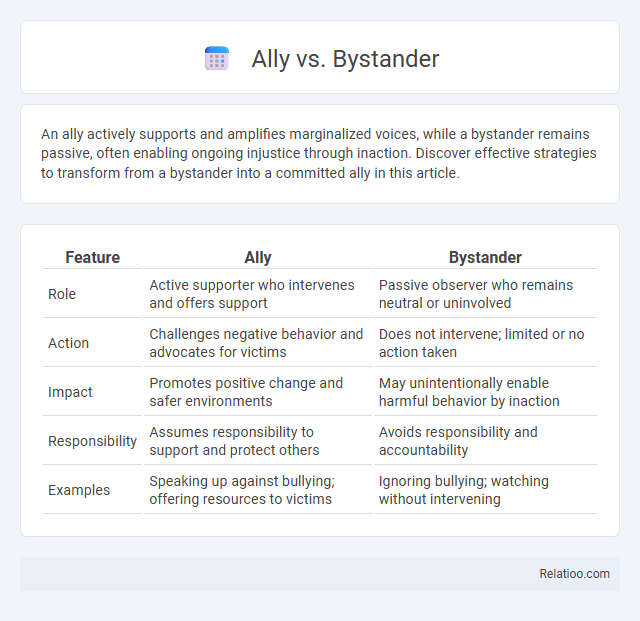An ally actively supports and amplifies marginalized voices, while a bystander remains passive, often enabling ongoing injustice through inaction. Discover effective strategies to transform from a bystander into a committed ally in this article.
Table of Comparison
| Feature | Ally | Bystander |
|---|---|---|
| Role | Active supporter who intervenes and offers support | Passive observer who remains neutral or uninvolved |
| Action | Challenges negative behavior and advocates for victims | Does not intervene; limited or no action taken |
| Impact | Promotes positive change and safer environments | May unintentionally enable harmful behavior by inaction |
| Responsibility | Assumes responsibility to support and protect others | Avoids responsibility and accountability |
| Examples | Speaking up against bullying; offering resources to victims | Ignoring bullying; watching without intervening |
Understanding the Difference: Ally vs Bystander
An ally actively supports and advocates for marginalized groups, using their influence to challenge injustice and promote equity. A bystander, however, remains passive, witnessing discrimination or harassment without intervention, which can perpetuate harm. Understanding the difference empowers your role in creating inclusive environments by choosing to act and support rather than stay silent.
The Role of an Ally in Social Change
The role of an ally in social change involves actively supporting marginalized groups by amplifying their voices and challenging systemic inequalities. Unlike bystanders who remain passive or apathetic, allies use their privilege to advocate for justice and create inclusive environments. Your commitment as an ally can drive meaningful progress by fostering empathy, raising awareness, and mobilizing collective action toward equity.
What Does It Mean to Be a Bystander?
A bystander is someone who witnesses an event, often a harmful or unjust situation, but chooses not to intervene or take action. Your role as a bystander can significantly impact whether an incident escalates or is addressed effectively. Understanding the difference between being a bystander and an ally highlights the importance of moving from passive observation to active support in combating injustice.
Key Traits of Effective Allies
Effective allies demonstrate active listening and empathy, consistently validating and supporting marginalized voices without overshadowing them. They use their privilege to amplify concerns and advocate for equitable change, maintaining accountability and openness to feedback. Courage in confronting injustice and ongoing self-education are essential traits that empower allies to foster inclusive environments.
The Risks and Rewards of Allyship
Being an ally involves actively supporting marginalized groups, which can expose individuals to social backlash or professional risks such as alienation or criticism. By contrast, bystanders often avoid conflict but forfeit opportunities to foster inclusivity and social justice. Effective allyship rewards individuals with strengthened community ties, enhanced empathy, and the potential to drive meaningful cultural or organizational change.
Bystander Effect: Why People Stay Silent
The bystander effect explains why individuals often remain silent during emergencies, as the presence of others diffuses personal responsibility and creates a social inhibition to act. Your role shifts when you choose to be an ally, actively intervening to support victims and break the cycle of inaction, contrasting the passive stance of bystanders. Understanding this dynamic empowers you to overcome hesitation and foster a safer, more responsive environment.
Practical Steps to Move from Bystander to Ally
Recognizing microaggressions and interrupting harmful behavior are crucial practical steps to move from bystander to ally. Educating oneself about systemic oppression and amplifying marginalized voices helps build informed advocacy. Committing to ongoing self-reflection and leveraging privilege to support equity fosters lasting allyship.
Common Myths About Being an Ally
Common myths about being an ally include the belief that allies must solve all problems or speak for marginalized groups, which can inadvertently overshadow their voices. You do not need perfect knowledge or actions; genuine support involves listening, learning, and amplifying others' experiences. Misconceptions also suggest allies must always be visible, but effective allyship often requires consistent, behind-the-scenes advocacy.
How to Support Victims as an Ally
Supporting victims as an ally involves actively listening to their experiences, validating their feelings, and amplifying their voices without overshadowing their agency. Allies must educate themselves on the issues faced by victims, intervene safely during instances of harm, and connect victims with appropriate resources such as counseling and legal aid. Consistent advocacy and creating inclusive environments help dismantle systemic barriers and foster long-term empowerment for those affected.
Creating a Culture of Allyship in Communities
Creating a culture of allyship in communities involves actively engaging allies who support marginalized groups by amplifying their voices and addressing inequities. Bystanders, when transformed into allies through education and awareness, contribute to a more inclusive environment by challenging discrimination and promoting empathy. Effective allyship fosters collective responsibility, encouraging continuous dialogue and sustained commitment to social justice within the community.

Infographic: Ally vs Bystander
 relatioo.com
relatioo.com